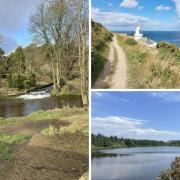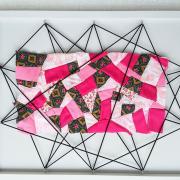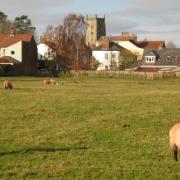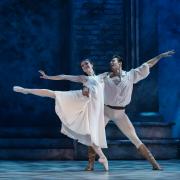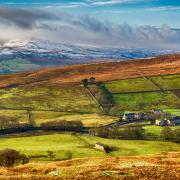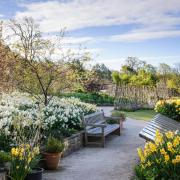F OR some in the area, racing at Thirsk this season is mainly about a non-runner. The White Horse of Kilburn is celebrating its 150th anniversary. No surprise then that its connections regard it as a kind of landmark victory over thoroughbreds on ...
Thirsk is currently full of references to the largest of Britain's 11 equine carvings, despite it being tethered out of sight of the town on Roulston Scar in the Hambleton Hills. Racing has been among those paying tribute, with a meeting in its honour - a fitting acknowledgement because Thirsk Races and the White Horse grew up together.
It was cut into an acre of hillside in 1857, two years after real horses began competing against each other in the 'back garden' of Thirsk Hall, the home of Squire Frederick Bell. The basics haven't changed much since that first contest on March 15th, 1855. A Bell at the Hall, Johnny Bell, still owns the course, and despite a personal preference for running an art gallery to racehorses, he regards it as a duty to contribute - as a director of the racecourse company - to the sport which his ancestor and a few chums introduced to the town.
In fact the family's links with the Turf go back much further. In the 18th century the Bells and others were involved in meetings at Hambleton, on the top of Sutton Bank. It still serves as a training centre but in 1740 was, along with York and Newmarket, one of only three venues in the country permitted by an Act of Parliament to stage 'proper' races.
Staking it all on history The White Horse of Kilburn is everyone's favourite this year. It's even a winner of the history stakes at Thirsk Races. Before that racing was recorded on the hilltop in 1612 when James I donated a gold cup, the forerunner of the Hambleton Cup, one of Thirsk's feature races. Much of this history, plus racing's influences on North Yorkshire and wider society, is told in one of the events being held in the area as part of the White Horse's birthday celebrations. Racing Times - An Exhibition of Horse Racing is at the World of James Herriot.
That's fitting because in the real-life veterinary practice of Sinclair and Wight, Donald Sinclair - Siegfried Farnon in the Herriot books - was the vet at Thirsk racecourse for over 40 years. The exhibition includes ephemera, photographs, among them a wonderful period shot of Middleham stable lads, aracecard made of silk to mark the Prince of Wales's visit to Thirsk's autumn meeting in 1895, and the colours of the Aga Khan.
They were worn by a pre-knighthood Gordon Richards on Turkhan, the 1940 winner of the St Leger when it was transferred there from Doncaster because of the war. Richards wasn't the only 'great' to ride at the course which promotes itself as 'country racing at its best'. Somewhere in Thirsk Hall is a much earlier example of the course's marketing. It's the bell the town crier rang in the market place, also owned by the Bell family until the 1960s, to announce the appearance of the legendary Fred Archer at the April meeting of 1884. History records that the tidings were as follows:
'At Thirsk Races this afternoon, the greatest jockey of this or any other age in England, Ireland, Scotland, or them there foreign parts, Mr Fred Archer, will positively ride. Mr Archer has arrived in Thirsk Toon, so there'll be no disappointment whatsumdever. So God save the Queen and Mr Fred Archer'. He duly rode two of his 241 winners of that year. It's easy to see why Thirsk plugs its countryside credentials. On a fine day there are terrific views from the stands of the Dales to the left and the Hambletons to the right. Christopher Tetley, the clerk of the course, becomes whimsical when he looks towards the escarpment where racing has some of its origins.
'It's rather nice to have the feeling of being looked upon by our ancestors.' He no doubt also agrees with those racegoers who regard Thirsk as one of the prettiest courses in the land, but also quirky and rather old-fashioned. Social changes may have won the day elsewhere, but there's no lowering of standards here. As the racecard reminds: 'Gentlemen Top: Racing cigarette advertising Above: Silk version of the racecard commemorating the visit of Edward, Prince of Wales to Thirsk Races in 1895 Left: Flying Bantam winning the Hawnby Handicap Stakes must wear a collared shirt and tie in the Club Enclosure'
The scene would be complete if only the White Horse wasn't facing the wrong way from Thirsk's point of view. Wouldn't the great immovable prefer to be looking down on other horses racing, instead of south-west into the Vale of York? To paraphrase James Herriot: if only it could talk.
.For details of racing at Thirsk call 01845 522276. www.thirskracecourse.net





